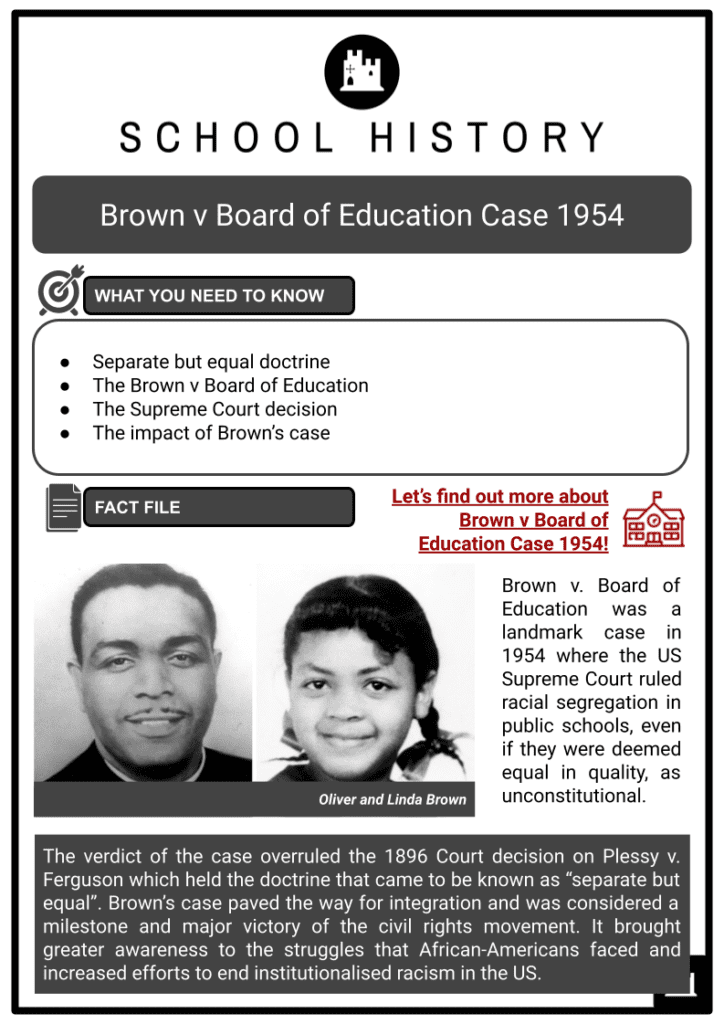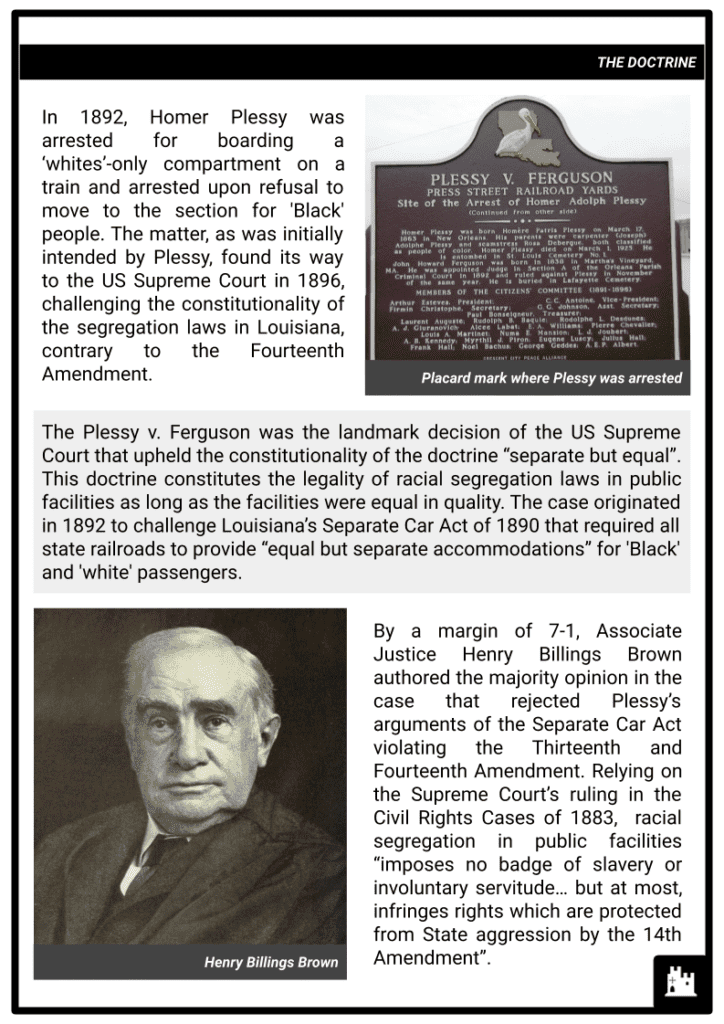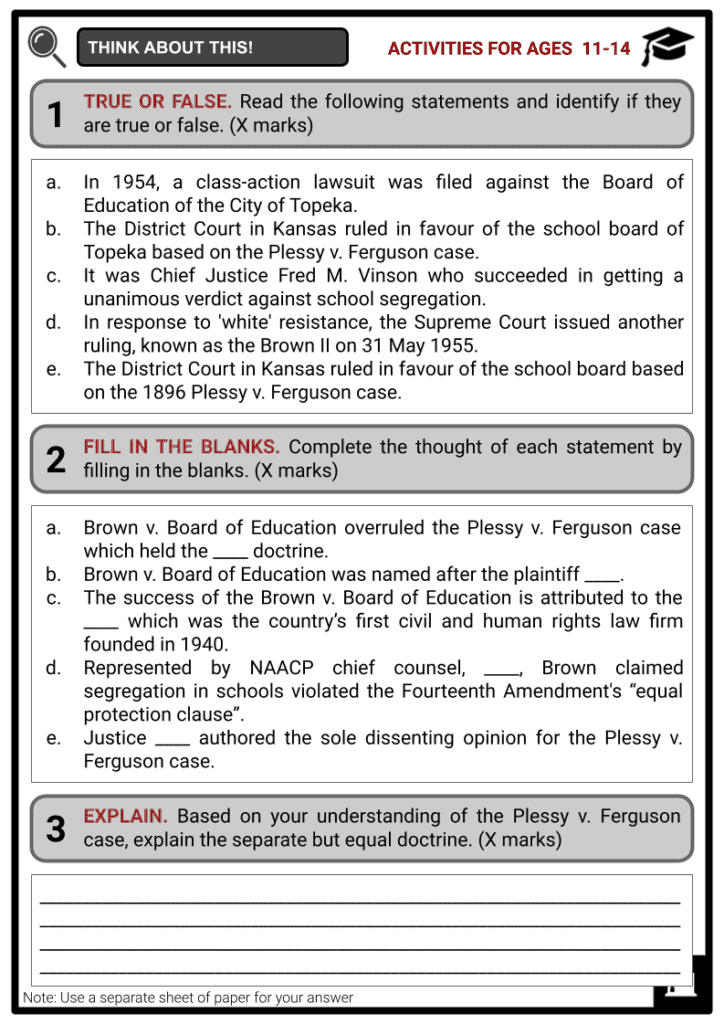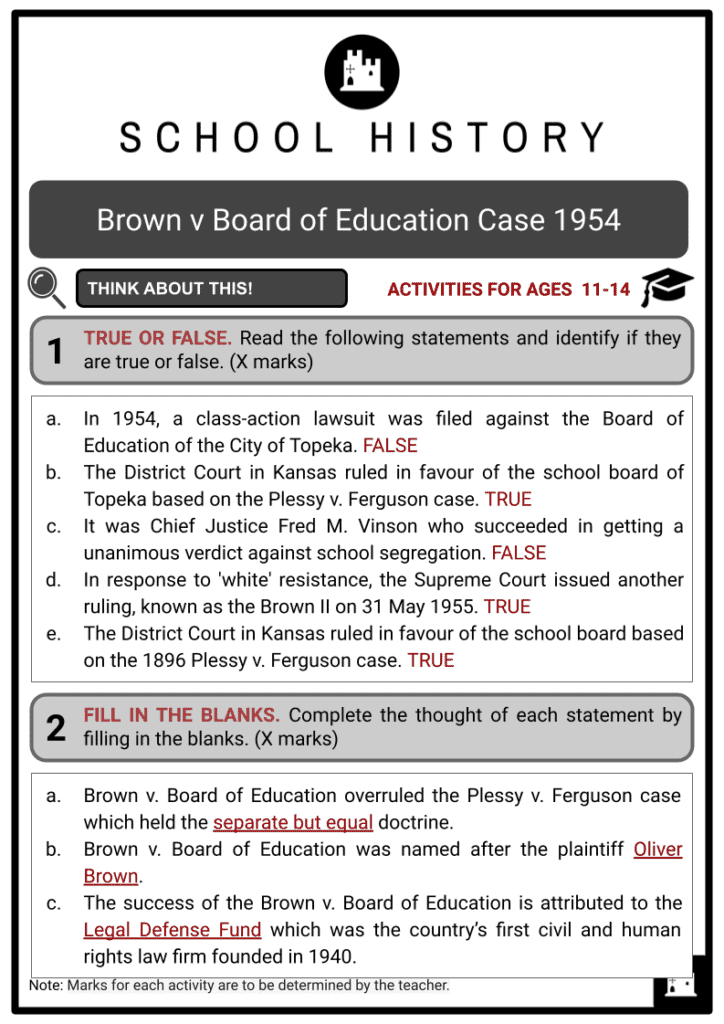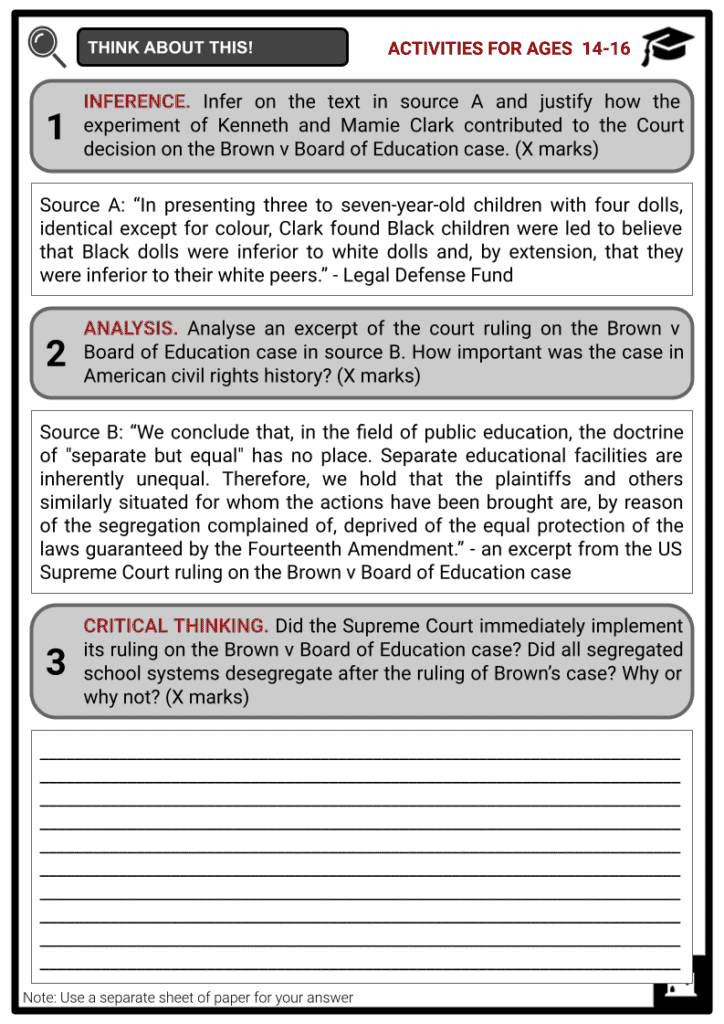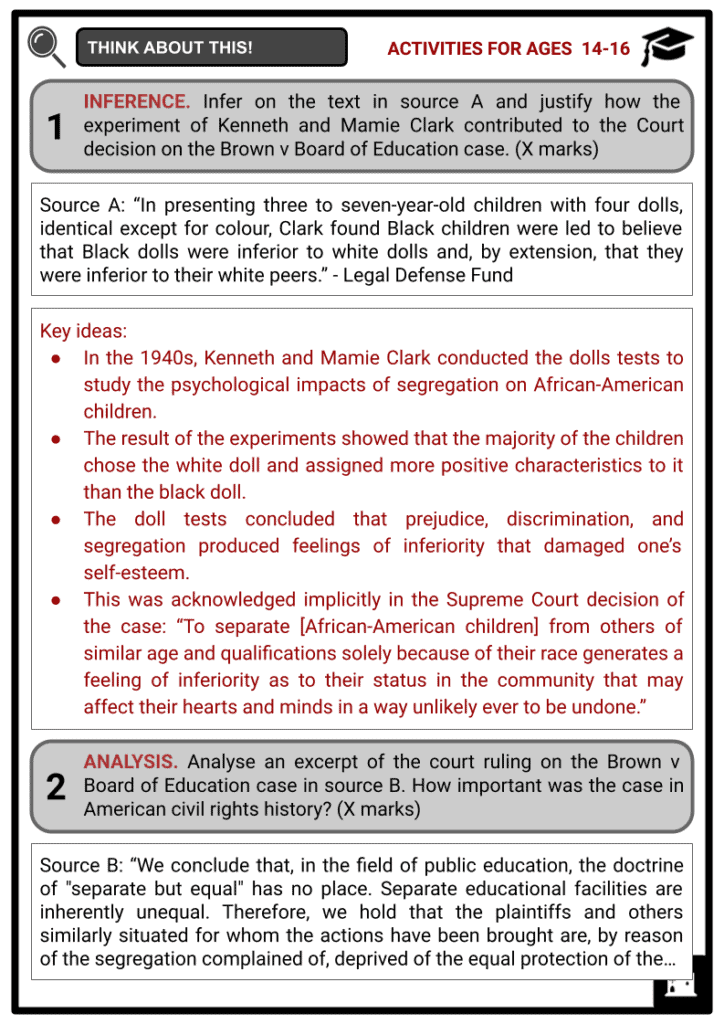Brown v Board of Education Case 1954 Worksheets
Do you want to save dozens of hours in time? Get your evenings and weekends back? Be able to teach about Brown v Board of Education Case 1954 to your students?
Our worksheet bundle includes a fact file and printable worksheets and student activities. Perfect for both the classroom and homeschooling!
Summary
- Separate but equal doctrine
- The Brown v Board of Education
- The Supreme Court decision
- The impact of Brown’s case
Key Facts And Information
Let’s find out more about Brown v Board of Education Case 1954!
Brown v. Board of Education was a landmark case in 1954 where the US Supreme Court ruled racial segregation in public schools, even if they were deemed equal in quality, as unconstitutional.
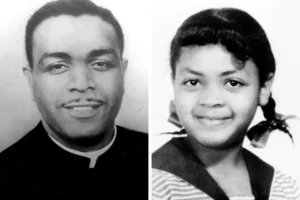
The verdict of the case overruled the 1896 Court decision on Plessy v. Ferguson which held the doctrine that came to be known as “separate but equal”. Brown’s case paved the way for integration and was considered a milestone and major victory of the civil rights movement. It brought greater awareness to the struggles that African-Americans faced and increased efforts to end institutionalised racism in the US.
THE DOCTRINE
- In 1892, Homer Plessy was arrested for boarding a ‘whites’-only compartment on a train and arrested upon refusal to move to the section for 'Black' people. The matter, as was initially intended by Plessy, found its way to the US Supreme Court in 1896, challenging the constitutionality of the segregation laws in Louisiana, contrary to the Fourteenth Amendment.
- The Plessy v. Ferguson was the landmark decision of the US Supreme Court that upheld the constitutionality of the doctrine “separate but equal”. This doctrine constitutes the legality of racial segregation laws in public facilities as long as the facilities were equal in quality. The case originated in 1892 to challenge Louisiana’s Separate Car Act of 1890 that required all state railroads to provide “equal but separate accommodations” for 'Black' and 'white' passengers.
- By a margin of 7-1, Associate Justice Henry Billings Brown authored the majority opinion in the case that rejected Plessy’s arguments of the Separate Car Act violating the Thirteenth and Fourteenth Amendment. Relying on the Supreme Court’s ruling in the Civil Rights Cases of 1883, racial segregation in public facilities “imposes no badge of slavery or involuntary servitude… but at most, infringes rights which are protected from State aggression by the 14th Amendment”.
- Though the court acknowledged the fact that the Fourteenth Amendment’s intention was to ensure equality among races, by nature, “it could not have been intended to abolish distinctions based upon colour, or to enforce social, as distinguished from political equality, or a commingling of the two races unsatisfactory to either.”
- Plessy’s lawyers did argue that the racial segregation laws implied that African-Americans were an inferior race and thus violated the Equal Protection Clause of the Fourteenth Amendment; however, the Court rejected it saying that racial prejudice could not be overcomed by legislation.
- Justice John Marshall Harlan authored the sole dissenting opinion for the case. He disagreed with the decision of the court to reject Plessy’s argument that the racial segregation laws implied that African-Americans were an inferior race. He accused the majority as being willfully ignorant on the subject.
- To prove his point, Harlan pointed out the Louisiana law that allowed African-American women who are nannies to 'white' children to be in the 'white'-only cars. This showed that African-Americans could only be in 'white'-only cars if they were “socially subordinate” to the 'whites’. Moreover, he argued that if many 19th century 'white' Americans considered themselves socially superior to other races, the US Constitution could not permit any classes among citizens in matters of civil rights.
- Harlan warned his colleagues that their decision would one day be as infamous as the Court’s decision in the Dred Scott v. Sandford in 1857 that denied citizenship to African-Americans. This prediction turned out to be correct as both the Dred Scott case and Plessy often sit at the top of lists of the Supreme Court's worst decisions.
- The greatest impact of the Plessy v. Ferguson's case is that it legitimised state laws that establish racial segregation in the southern states. The legislative achievements during the period of Reconstruction were erased through the “separate but equal” doctrine justified by the Plessy v. Ferguson case.
- Civil rights in the United States have been set back with many businesses defining themselves as “serving ‘whites’ only”. Though the case was eventually overturned in 1854 through the Brown v. Board of Education of Topeka, it served as a controlling judicial precedent for many years of the Jim Crow system.
THE CASE
- In 1951, a class-action lawsuit was filed against the Board of Education of the City of Topeka Kansas to call for the school district to reverse its policy of racial segregation. Separate elementary school facilities for 'Black' and 'white' students were maintained in 12 communities as permitted, but not required, by the Kansas law.
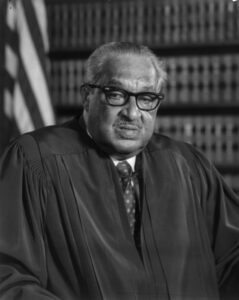
Thurgood Marshall - The case was named after Oliver Brown, an African-American assistant pastor at their local church. He was convinced to file a lawsuit when his then third-grade daughter, Linda Carol Brown, was refused admittance to the public school closest to their home and required her instead to attend a segregated school for 'Black' people farther from their home. Linda had to walk six blocks just to get to the bus school stop to ride to Monroe Elementary that was 1.6 km away from her house, whereas the 'white' school Sumner Elementary was only seven blocks away.
- Represented by National Association for the Advancement of Colored People or NAACP chief counsel, Thurgood Marshall, Brown claimed segregation in schools violated the Fourteenth Amendment's “equal protection clause”. Brown itself was not a single case because it consisted of a coordinated group of five lawsuits against school districts in Kansas, Delaware, Virginia, South Carolina, and the District of Columbia.
- The plaintiffs of the case consisted of thirteen parents on behalf of their children: Oliver Brown, Darlene Brown, Lena Carper, Sadie Emmanuel, Marguerite Emerson, Shirley Fleming, Zelma Henderson, Shirley Hodison, Maude Lawton, Alma Lewis, Iona Richardson, Vivian Scales, and Lucinda Todd.
- To institute legal proceedings to overturn the separate but equal doctrine, Marshall recruited attorneys Constance Baker Motley, Louis Redding, Harold R. Boulware, Jack Greenberg, George E.C. Hayes, Robert Carter, Spottswood Robinsons, James Nabrit, Oliver Hill, and Charles and John Scott.
- The District Court in Kansas ruled in favour of the school board based on the 1896 Plessy v. Ferguson case. It stipulated that segregation in facilities was valid as long they followed the doctrine of "separate but equal".
THE SUPREME COURT DECISION
- The Brown v. Board of Education case was forwarded to the US Supreme Court. Then-Chief Justice Fred M. Vinson held the opinion that the Plessy verdict should stand; however, this quickly changed when he died in 1953 and was replaced by Chief Justice Earl Warren as appointed by President Dwight D. Eisenhower.
- Warren succeeded in getting a unanimous verdict against school segregation although it took another five months to yield and another year to issue an order enforcing the decision because of its controversial nature. On 17 May 1954, the US Supreme Court ruled that racial segregation in public schools was unconstitutional. The Court’s decision overruled the Plessy v. Ferguson case stating that the "separate but equal" doctrine was unconstitutional for US public educational institutions.
- The success of the Brown v. Board of Education is attributed to the Legal Defense Fund or LDF which was the country’s first civil and human rights law firm founded in 1940 under the leadership of Marshall. The LDF relied upon the research of historians and the works of social researchers. The famous doll experiments of Kenneth and Mamie Clark that demonstrated the impact of segregation towards African-American children were central to the LDF’s success.
THE IMPACT
- By May 1955, the Supreme Court issued lower federal courts, district courts, and school boards to desegregate “with all deliberate speed.” The case set a precedent to end racial segregation in public facilities and strengthened civil rights organisations.
- After the historic success of the Brown v. Board of Education case, racial segregation in schools was deemed unconstitutional. However, contrary to the Supreme Court's decision, many states refused to integrate and maintained the mandatory segregation laws of Jim Crow policies.
- On 31 May 1955, in response to this 'white' resistance, the Supreme Court issued another ruling, known as the Brown II, mandating school districts to comply and to integrate “with all deliberate speed.” Despite the opposition of Arkansas Governor Orval Faubus, Virgil T. Blossom, who worked as the superintendent of the Little Rock School District from 1953 to 1958, proposed a plan to comply with the integration. This proposal was known as the Blossom Plan, aiming to integrate high school students, which would then be followed by lower grades.
- Following this, nine African-American students enrolled at Central High. They were recruited for the integration by Daisy Gatson Bates, who served as the president of the NAACP in Arkansas and co-publisher of the Arkansas State Press, a known African-American newspaper. Later on, the group became known as the Little Rock Nine as they were at the centre of the fight against racial segregation in public schools in the United States.
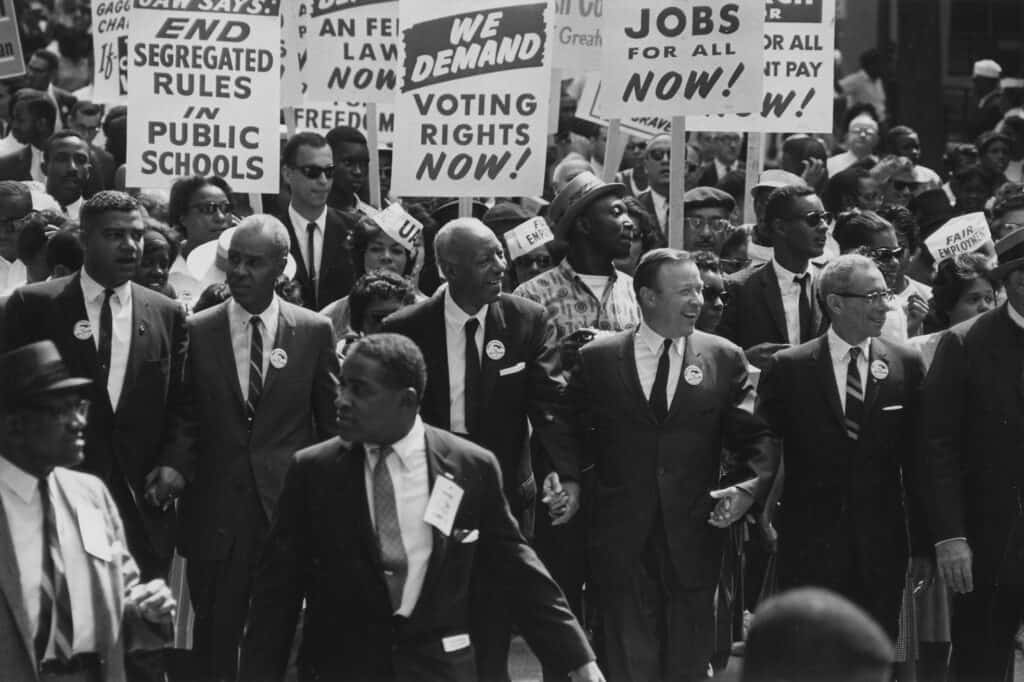
Civil rights movement - These events showed the collective efforts of the civil rights activists as well as the media in bringing about equality in education in the US. Moreover, despite historical barriers, African-Americans believed education to be a means of changing the condition of their lives (Billingsly, 1993). This is why by 1970, African-American college enrollment rose to about 10 percent of the total, three times the prewar figure.
Image Sources
- https://www.washingtonpost.com/rf/image_960w/2010-2019/WashingtonPost/2018/03/27/Interactivity/Images/COMPBrowns327.jpg
- https://upload.wikimedia.org/wikipedia/commons/5/5d/Thurgood-marshall-2.jpg
- https://upload.wikimedia.org/wikipedia/commons/4/4c/Civil_Rights_March_on_Washington%2C_D.C._%28Leaders_marching_from_the_Washington_Monument_to_the_Lincoln_Memorial%29_-_NARA_-_542010.jpg

